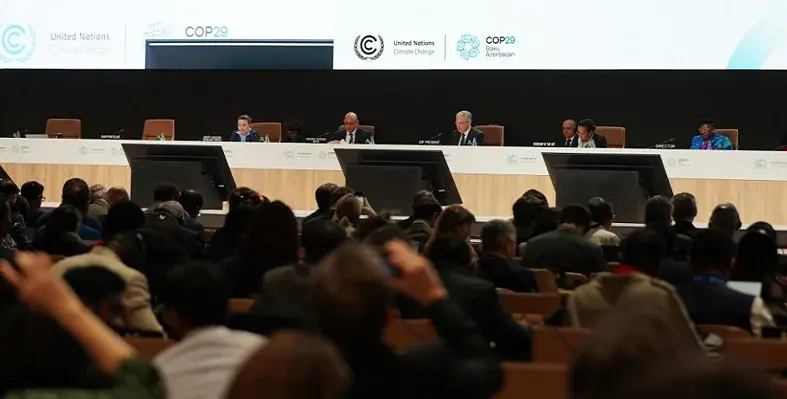There has been a mixed response to the outcome of COP29 and the Baku Finance Goal (BFG) that was announced in the final hour
There was plenty of drama in the conclusion of the 29th edition of the United Nations Climate Change Conference, held in Baku, as international stakeholders representing 200 countries vied to hammer out a deal that would continue the energy transition and support developing countries in their battle against climate change.
The conference opened under headlines dominated by Ilham Aliyev, the President of country host Azerbaijan, who described oil and gas as a “gift from God” and criticised misinformation spread by western media, charities and politicians. From this point, persistent protests from climate demonstrators and campaigners set the background clamour for the event as it ran through the agenda, as the spotlight began to focus the eventual deal that would mark its success, or otherwise.
As the debate began in earnest, the temperature began to rise and at one point in the proceedings it appeared as though a deal might not be reached following the breakdown of discussions and dozens of nations walking out.
However, this tumultuous finale, delegates returned to the room and a period of intense diplomacy saw a new deal struck in the dying hours of the conference
Over the line in Baku
The culmination of the debate was announced in the form of the BFG.
This represents a commitment to channel US$1.3 trillion of climate finance to the developing world each year. At its core is a target for developed countries to take the lead on mobilising at least US$300bn per year for developing countries by 2035.
In addition, there was a conclusion for the Article 6 negotiation on high integrity carbon markets under the UN. According to the COP29 announcement, financial flows from complaint carbon markets could reach US$1 trillion per year by 2050 and have the potential to reduce the cost of implementing national climate plans by US$250bn per year.
“We have unlocked one of the most complex and technical challenges in climate diplomacy,” said COP29 lead negotiator Yalchin Rafiyev. “Article 6 is hard to understand, but its impacts will be clear in our everyday lives. It means coal plants decommissioned, wind farms built and forests planted. It means a new wave of investment in the developing world.”
In addition, the full operationalisation of the Loss and Damage Fund was unveiled after originally being agreed during COP27 in Egypt. The fund aims to provide financial assistance to countries most vulnerable to the impacts of climate change, with the decision to launch operations made agreed during COP28.
COP29 went further by ensuring the fund’s operationalisation, including several important related agreements including the Trustee Agreement and the Secretariat Hosting Agreement. To date, the total pledged financial support for the fund exceeds US$730mn.
The best outcome or an “optical illusion”?
“When the world came to Baku, people doubted that Azerbaijan could deliver. They doubted that everyone could agree. They were wrong on both counts,” remarked COP29 President, Mukhtar Babayev. “With this breakthrough, the Baku Finance Goal will turn billions into trillions over the next decade. We have secured a trebling of the core climate finance target for developing countries each year.
“The Baku Finance Goal represents the best possible deal we could reach, and we have pushed the donor countries as far as possible. We have forever changed the global financial architecture and taken a significant step towards delivering the means to deliver a pathway to 1.5°C. The years ahead will not be easy. The science shows that the challenges will only grow. Our ability to work together will be tested. The Baku Breakthrough will help us weather the coming storms.”
This positive judgement is not one universally shared however, with critics suggesting that developed countries were not meeting their responsibilities to raise resources to support developing nations. Indian negotiator, Chandni Raina was one of the leading voices in dissent, labelling it “an optical illusion” that “will not address the enormity of the challenge we all face.”
Ali Mohamed, Kenya’s special envoy for climate change and chair of the African group of negotiators, also expressed his disappointment. “Africa leaves Baku with realism and resignation as COP29 progress falls far short of our hopes,” he stated in a post on X. “When Africa loses, the world loses – its minerals, biodiversity & stability. The US$300bn/year by 2035 is too little, too late for a continent facing climate devastation while contributing least to emissions.”
While the debate continues for the time being over the effectiveness of the new deal, eyes are already looking ahead to COP30 which will be hosted in Brazil from 10-21 November 2025. Certainly, these proceedings will be heavily coloured by a new leader amongst the developed countries in the form of US President Donald Trump. Having recently nominated a fracking CEO to lead the US Energy Department, there are fears the President will step back from the country’s climate commitments.
Time, then, will tell whether the critics of the BFG are proven correct or whether the agreement will hold together the climate effort in the potentially subdued conferences that could lie ahead.






